Our philosophy is to educate and empower patients on how to prevent further injury and to promote a healthy and active lifestyle through effective movement strategies.
How We Treat
How We Treat
We consider additional psychological and emotional factors that may affect a patient's presentation as well as their expectations and beliefs about their recovery.
Class IV Laser
Class IV laser is a non-invasive use of laser energy that bio-stimulates tissues to increase the immune response, decrease swelling and modulate pain. The key benefit is the depth of penetration within little to no discomfort.
Manual Therapy
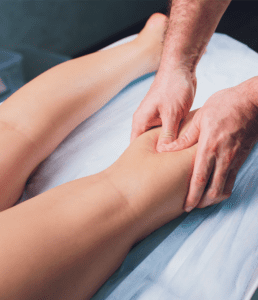 We offer a curated session with soft tissue mobilization, joint manipulation and mobility designed to induce relaxation, modulate pain and control swelling. Therapists use skilled hand movements to improve tissue and muscle extensibility focusing on your individual needs.
We offer a curated session with soft tissue mobilization, joint manipulation and mobility designed to induce relaxation, modulate pain and control swelling. Therapists use skilled hand movements to improve tissue and muscle extensibility focusing on your individual needs.
Trigger Point Dry Needling
Trigger Point Dry Needling (TDN) is a therapeutic technique that decreases musculoskeletal pain through targeting myofascial trigger points. Myofascial trigger points are areas in skeletal muscle that are tender and twitch when stimulated. Dry needling is often used in the context of musculoskeletal conditions, particularly those associated with myofascial pain syndrome.
At SetPT, we treat all conditions related to the musculoskeletal system, including pelvic floor dysfunction as well as neurological and chronic conditions. Our one-on-one sessions are designed with YOU in mind and we pride ourselves that a physical therapist provides the entirety of the treatment session.
One-on-one PT
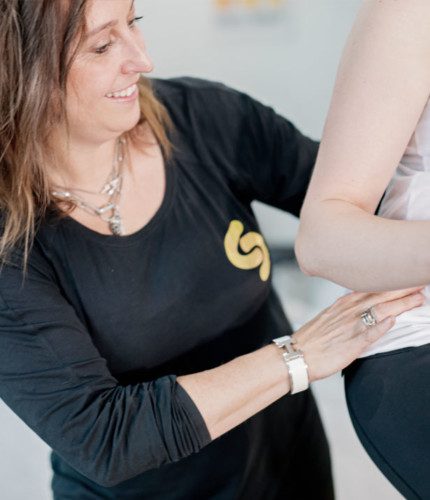 You will spend an hour with the physical therapist at your initial visit and have the opportunity to describe your health history and what led you to schedule an appointment. This session includes a thorough assessment to identify the impact of your movement and function. Using the information gained from the evaluation, your therapist creates a unique treatment program for you. This investment in time upfront allows the therapist to get to know you as a person and not as a diagnosis.
You will spend an hour with the physical therapist at your initial visit and have the opportunity to describe your health history and what led you to schedule an appointment. This session includes a thorough assessment to identify the impact of your movement and function. Using the information gained from the evaluation, your therapist creates a unique treatment program for you. This investment in time upfront allows the therapist to get to know you as a person and not as a diagnosis.
Follow-up treatment sessions are also scheduled for up to one hour with the physical therapist, who will provide manual therapy, instruct in exercises and functional movements, and most importantly, educate YOU so that you have the knowledge to make informed decisions about your health.
Several of our therapists have become experts in treating complicated conditions such as Ehlers Danlos Syndrome (EDS), Postural Orthostatic Tachycardia Syndrome (POTS), chronic/persistent pain, migraines, and Temporomandibular Dysfunction (TMD), and Multiple Sclerosis (MS).
Biofeedback for the Pelvic Floor
Biofeedback for the pelvic floor is a therapeutic technique used to help individuals gain awareness and control over the muscles in the pelvic floor. The pelvic floor is a group of muscles and connective tissues that support the organs in the pelvic region, including the bladder, uterus (in women), and rectum. These muscles play a crucial role in various bodily functions, such as controlling urination and bowel movements, supporting the pelvic organs, and facilitating sexual function. For more information about the pelvic floor, click here.
Biofeedback is a method that provides real-time information to individuals about their physiological processes, such as muscle activity, in a way that allows them to learn how to control and improve these functions. In the context of pelvic floor therapy, biofeedback typically involves the following steps:
Sensors: Special sensors or electrodes are placed on or near the pelvic floor muscles. These sensors detect and measure muscle activity.
Feedback: The information from the sensors is relayed to a monitoring device in real-time, which then provides visual feedback, which allows the individual to become aware of their pelvic floor muscle activity.
Training: With the real-time feedback, the individual can learn how to voluntarily contract and relax (or downtrain) their pelvic floor muscles. This can be helpful for conditions such as urinary incontinence, pelvic pain, or sexual dysfunction. Biofeedback can teach individuals how to strengthen or relax these muscles as needed. Patients may also receive guidance on how to practice these exercises at home to continue improving their pelvic floor muscle function.
Biofeedback for the pelvic floor is often used as part of a comprehensive treatment plan for various pelvic floor disorders, including:
Stress incontinence: Biofeedback can help individuals learn to strengthen their pelvic floor muscles to reduce urine leakage when pressure is exerted on the bladder, such as during coughing, sneezing, or laughing.
Urge incontinence: It can assist individuals in gaining better control over their bladder muscles and reducing the frequency and urgency of urination.
Pelvic pain: Biofeedback can help with relaxation techniques for individuals experiencing pelvic pain conditions, such as pelvic floor dysfunction or pelvic floor muscle tension.
Sexual dysfunction: For some individuals, biofeedback may be used to address sexual problems related to the pelvic floor muscles, such as vaginismus or erectile dysfunction.
Blood Flow Restriction
Blood flow restriction (BFR), also known as vascular occlusion training, is a training technique used in exercise and rehabilitation to enhance muscle development and strength using resistance training with restricted blood flow. BFR involves temporarily reducing the blood supply to a working muscle by applying a tourniquet or specialized BFR cuffs or bands to the proximal (closer to the body) portion of a limb, typically the upper arm or upper thigh. This creates a partial occlusion of blood flow into and out of the muscle while allowing arterial blood to enter.
Here's how blood flow restriction works and its potential benefits:
Reduced Blood Flow: The application of a tourniquet or cuffs reduces the amount of oxygen and nutrients that can enter the muscle, leading to a state of "metabolic stress" within the muscle.
Increased Muscle Activation: With limited oxygen and nutrients, the muscle cells experience metabolic changes, such as increased lactate production. This can lead to increased muscle fiber recruitment and motor unit activation, which may not typically occur with traditional resistance training.
Muscle Growth: Blood flow restriction training is believed to stimulate muscle hypertrophy (growth) through mechanisms like muscle cell swelling, increased cellular signaling, and muscle protein synthesis, despite using lower training loads than traditional strength training.
Reduced Joint Stress: BFR allows individuals to use lighter weights or resistance, reducing the stress on joints, which can be beneficial for individuals with joint issues or during rehabilitation.
Rehabilitation: BFR has been used in physical therapy and rehabilitation to help regain muscle strength and function following injuries or surgery.
Time Efficiency: BFR can lead to muscle development with lower training volume and shorter workouts compared to traditional strength training, making it an attractive option for those with limited time for exercise.
BFR is not recommended for all patients such as people with hypertension, cardiovascular disease, and deep vein thrombosis. It is important that the cuffs fit correctly and are not applying too much pressure, which could lead to injury. At Set, we recommend that you consult with a healthcare professional prior to starting BFR training. It can be integrated into a home program and BFR training is typically performed 2-3 times per week for 15-30 minutes session. Click here (link in shop) for a link to BFR cuffs for the upper and lower body.
Myofascial Cupping
Myofascial cupping is a therapeutic technique that involves the use of special cups to create suction on the skin, which is believed to help release tension in the fascia and muscles. Fascia is a connective tissue that surrounds and supports muscles, tendons, and other structures in the body. Myofascial cupping is a variation of traditional cupping therapy, which has been used in traditional Chinese medicine for centuries. While traditional cupping primarily focuses on improving energy flow, myofascial cupping is specifically directed at addressing muscular and fascial issues.
Here's how myofascial cupping typically works:
Cups: Myofascial cupping uses cups made of various materials, such as silicone, plastic, or glass. These cups are applied to the skin over the areas of the body with muscle tightness or fascial restrictions.
Suction: The cups create a suction effect on the skin that lifts the skin and underlying tissues into the cup, creating a vacuum-like effect.
Tissue Release: As the cups are placed on the skin and the suction is applied, they can help release tension and adhesions in the myofascial tissue. The suction can also increase blood flow to the area, which may aid in the healing process.
Glide or Static Application: Practitioners can either keep the cups stationary or move them across the skin in a gliding fashion. The choice of technique depends on the goals of the treatment and the practitioner's training and expertise.
Benefits of myofascial cupping may include: reduced muscle tension, pain relief, improvement in circulation, improvement in range of motion, and increased recovery due to post-exercise soreness.
Some patients may experience temporary skin discolorations or bruising as a result of cupping, but these effects are generally mild and resolve over time.
Different brands of tapes include Kinesio Tape, Dynamic Tape, RockTape, Leukotape, and a variety of athletic tape. With so many different types of tape on the market, it can be confusing what tape to buy and how to apply it in a way that will offer a therapeutic benefit.
Benefits of Tape
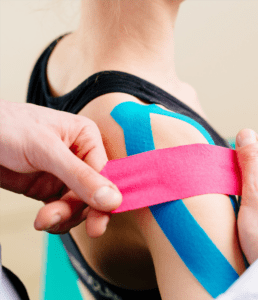 Pain Relief: Tape is applied over or around an injured area and can decrease the discomfort by support the injured area and decreasing pressure on pain receptors in the skin.
Pain Relief: Tape is applied over or around an injured area and can decrease the discomfort by support the injured area and decreasing pressure on pain receptors in the skin.
Swelling Reduction: By applying the tape with a specific tension and direction, it can help facilitate lymphatic drainage and reduce swelling or edema in injured or inflamed areas.
Joint and Muscle Support: Tapes like athletic tape and Leukotape provide more support to a weakened or injured joint or muscle which may reduce the risk of reinjury whereas elastic tapes like Kinesio Tape, Dynamic Tape and RockTape can enhance muscle proprioception (awareness) and facilitate proper muscle activation based on the direction of pull and the amount of tension applied during taping.
Enhanced Performance: Some athletes and active individuals use tape to enhance performance. Some believe that the tape can improve muscle activation and decrease muscle fatigue.
Injury Prevention: Tape can be used proactively to help prevent injuries by providing additional support and promoting proper movement patterns. In a study about young volleyball players, results showed that Dynamic Tape improved knee laxity when the tape was applied.
Postural Correction: In some cases, Kinesio tape is applied to assist in posture correction by gently pulling or lifting the skin and underlying tissues to encourage a more upright and balanced posture.
Types of Tape
Kinesio Tape is a specialized, elastic adhesive tape that mimics the elasticity of human skin. It is designed to either inhibit or active muscle based on application of the tape and it can help in reduction of pain and spasm, decrease swelling, and support tendons and ligaments. There are several brands on the market. At Set we recommend KINESIO® TEX GOLD and KINESIO® TEX GOLD LIGHT TOUCH+ (LT), which is gentle for sensitive skin, because the tape stays on the skin better than other brands of tape.
RockTape is a brand of kinesiology tape, which is a specialized type of therapeutic tape used in sports and physical therapy for various applications. RockTape is known for its pre-cut strips, variety of designs and durability, which is beneficial in athletic events and physically demanding activities.
Dynamic Tape mechanically acts like a spring, decelerating motion to improve movement. Unlike Kinesio Tape and RockTape which only stretch in one direction, Dynamic Tape stretches in multiple directions and has the increased resistance, like a bungee cord. This allows the tape to be applied to a muscle in the shortened position without limiting range of motion. The best part of Dynamic Tape may be the design.
Leukotape offers stronger joint support and stability, making it invaluable for athletes, individuals with joint instability, or those recovering from injuries or surgeries. Its strong adhesive properties and non-elastic nature provide rigid reinforcement to help prevent excessive joint movement and reduce the risk of further injury. Physical therapist may use Leukotape to correct faulty movement pattern such as excessive medial movement of the patella during a single leg squat.
Athletic tape, whether used after an injury or as a preventive measure, provides benefits in enhancing joint stability and reducing injury risk. It offers support to weakened or vulnerable joints, aiding in a safe return to physical activity or minimizing the chances of injuries during sports or rigorous training. Properly applied athletic tape can limit excessive joint movement, increase confidence and improve performance.
Shop
Applying tape correctly requires training and expertise, so it's advisable to have a healthcare professional, such as a physical therapist, demonstrate its proper use or apply it for you. Additionally, it's crucial to ensure that the tape is not too tight or applied in a way that restricts circulation or causes discomfort. Check out our SHOP for links to purchase different brands of tape that the team at Set recommends.
Real-Time Ultrasound (RTUS)
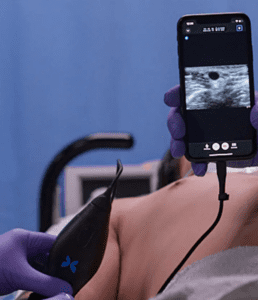 At all clinics we offer RTUS using the Butterfly
At all clinics we offer RTUS using the Butterfly
Diagnostic real-time ultrasound is a medical imaging technique that utilizes high-frequency sound waves to produce real-time images of the internal structures of the human body. This non-invasive and radiation-free technology is widely employed in various medical specialties, including obstetrics, cardiology, and musculoskeletal imaging. Real-time ultrasound allows healthcare professionals to visualize and assess organs, tissues, and blood flow in a dynamic and continuous manner, aiding in the diagnosis and monitoring of a wide range of medical conditions. The real-time aspect of the technology enables immediate feedback, facilitating quick decision-making in clinical settings and improving patient care.
One notable innovation in the field of diagnostic ultrasound is the Butterfly iQ, a handheld, pocket-sized ultrasound device developed by Butterfly Network Inc., which Set has in each location. The device features a unique transducer array known as the "Butterfly," which utilizes advanced semiconductor technology to enable multiple modes of imaging, including 2D, color Doppler, and 3D imaging. The Butterly iQ exemplifies the potential of innovative ultrasound technologies to enhance diagnostic capabilities and improve healthcare outcomes.
Exercise Programs
We will make this about you. We want you to succeed at home but also recognize that the program needs to be targeted to your injury, time and space. So you are never just handed a piece of paper instead your program is designed with you in mind and evolves as you evolve.
We consider additional psychological and emotional factors that may affect a patient's presentation as well as their expectations and beliefs about their recovery.
Class IV Laser
Class IV laser is a non-invasive use of laser energy that bio-stimulates tissues to increase the immune response, decrease swelling and modulate pain. The key benefit is the depth of penetration within little to no discomfort.
Manual Therapy
We offer a curated session with soft tissue mobilization, joint manipulation and mobility designed to induce relaxation, modulate pain and control swelling. Therapists use skilled hand movements to improve tissue and muscle extensibility focusing on your individual needs.
Trigger Point Dry Needling
Trigger Point Dry Needling (TDN) is a therapeutic technique that decreases musculoskeletal pain through targeting myofascial trigger points. Myofascial trigger points are areas in skeletal muscle that are tender and twitch when stimulated. Dry needling is often used in the context of musculoskeletal conditions, particularly those associated with myofascial pain syndrome.
At SetPT, we treat all conditions related to the musculoskeletal system, including pelvic floor dysfunction as well as neurological and chronic conditions. Our one-on-one sessions are designed with YOU in mind and we pride ourselves that a physical therapist provides the entirety of the treatment session.
One-on-one PT
You will spend an hour with the physical therapist at your initial visit and have the opportunity to describe your health history and what led you to schedule an appointment. This session includes a thorough assessment to identify the impact of your movement and function. Using the information gained from the evaluation, your therapist creates a unique treatment program for you. This investment in time upfront allows the therapist to get to know you as a person and not as a diagnosis.
Follow-up treatment sessions are also scheduled for up to one hour with the physical therapist, who will provide manual therapy, instruct in exercises and functional movements, and most importantly, educate YOU so that you have the knowledge to make informed decisions about your health.
Several of our therapists have become experts in treating complicated conditions such as Ehlers Danlos Syndrome (EDS), Postural Orthostatic Tachycardia Syndrome (POTS), chronic/persistent pain, migraines, and Temporomandibular Dysfunction (TMD), and Multiple Sclerosis (MS).
Biofeedback for the Pelvic Floor
Biofeedback for the pelvic floor is a therapeutic technique used to help individuals gain awareness and control over the muscles in the pelvic floor. The pelvic floor is a group of muscles and connective tissues that support the organs in the pelvic region, including the bladder, uterus (in women), and rectum. These muscles play a crucial role in various bodily functions, such as controlling urination and bowel movements, supporting the pelvic organs, and facilitating sexual function. For more information about the pelvic floor, click here.
Biofeedback is a method that provides real-time information to individuals about their physiological processes, such as muscle activity, in a way that allows them to learn how to control and improve these functions. In the context of pelvic floor therapy, biofeedback typically involves the following steps:
Sensors: Special sensors or electrodes are placed on or near the pelvic floor muscles. These sensors detect and measure muscle activity.
Feedback: The information from the sensors is relayed to a monitoring device in real-time, which then provides visual feedback, which allows the individual to become aware of their pelvic floor muscle activity.
Training: With the real-time feedback, the individual can learn how to voluntarily contract and relax (or downtrain) their pelvic floor muscles. This can be helpful for conditions such as urinary incontinence, pelvic pain, or sexual dysfunction. Biofeedback can teach individuals how to strengthen or relax these muscles as needed. Patients may also receive guidance on how to practice these exercises at home to continue improving their pelvic floor muscle function.
Biofeedback for the pelvic floor is often used as part of a comprehensive treatment plan for various pelvic floor disorders, including:
Stress incontinence: Biofeedback can help individuals learn to strengthen their pelvic floor muscles to reduce urine leakage when pressure is exerted on the bladder, such as during coughing, sneezing, or laughing.
Urge incontinence: It can assist individuals in gaining better control over their bladder muscles and reducing the frequency and urgency of urination.
Pelvic pain: Biofeedback can help with relaxation techniques for individuals experiencing pelvic pain conditions, such as pelvic floor dysfunction or pelvic floor muscle tension.
Sexual dysfunction: For some individuals, biofeedback may be used to address sexual problems related to the pelvic floor muscles, such as vaginismus or erectile dysfunction.
Blood Flow Restriction
Blood flow restriction (BFR), also known as vascular occlusion training, is a training technique used in exercise and rehabilitation to enhance muscle development and strength using resistance training with restricted blood flow. BFR involves temporarily reducing the blood supply to a working muscle by applying a tourniquet or specialized BFR cuffs or bands to the proximal (closer to the body) portion of a limb, typically the upper arm or upper thigh. This creates a partial occlusion of blood flow into and out of the muscle while allowing arterial blood to enter.
Here's how blood flow restriction works and its potential benefits:
Reduced Blood Flow: The application of a tourniquet or cuffs reduces the amount of oxygen and nutrients that can enter the muscle, leading to a state of "metabolic stress" within the muscle.
Increased Muscle Activation: With limited oxygen and nutrients, the muscle cells experience metabolic changes, such as increased lactate production. This can lead to increased muscle fiber recruitment and motor unit activation, which may not typically occur with traditional resistance training.
Muscle Growth: Blood flow restriction training is believed to stimulate muscle hypertrophy (growth) through mechanisms like muscle cell swelling, increased cellular signaling, and muscle protein synthesis, despite using lower training loads than traditional strength training.
Reduced Joint Stress: BFR allows individuals to use lighter weights or resistance, reducing the stress on joints, which can be beneficial for individuals with joint issues or during rehabilitation.
Rehabilitation: BFR has been used in physical therapy and rehabilitation to help regain muscle strength and function following injuries or surgery.
Time Efficiency: BFR can lead to muscle development with lower training volume and shorter workouts compared to traditional strength training, making it an attractive option for those with limited time for exercise.
BFR is not recommended for all patients such as people with hypertension, cardiovascular disease, and deep vein thrombosis. It is important that the cuffs fit correctly and are not applying too much pressure, which could lead to injury. At Set, we recommend that you consult with a healthcare professional prior to starting BFR training. It can be integrated into a home program and BFR training is typically performed 2-3 times per week for 15-30 minutes session. Click here (link in shop) for a link to BFR cuffs for the upper and lower body.
Myofascial Cupping
Myofascial cupping is a therapeutic technique that involves the use of special cups to create suction on the skin, which is believed to help release tension in the fascia and muscles. Fascia is a connective tissue that surrounds and supports muscles, tendons, and other structures in the body. Myofascial cupping is a variation of traditional cupping therapy, which has been used in traditional Chinese medicine for centuries. While traditional cupping primarily focuses on improving energy flow, myofascial cupping is specifically directed at addressing muscular and fascial issues.
Here's how myofascial cupping typically works:
Cups: Myofascial cupping uses cups made of various materials, such as silicone, plastic, or glass. These cups are applied to the skin over the areas of the body with muscle tightness or fascial restrictions.
Suction: The cups create a suction effect on the skin that lifts the skin and underlying tissues into the cup, creating a vacuum-like effect.
Tissue Release: As the cups are placed on the skin and the suction is applied, they can help release tension and adhesions in the myofascial tissue. The suction can also increase blood flow to the area, which may aid in the healing process.
Glide or Static Application: Practitioners can either keep the cups stationary or move them across the skin in a gliding fashion. The choice of technique depends on the goals of the treatment and the practitioner's training and expertise.
Benefits of myofascial cupping may include: reduced muscle tension, pain relief, improvement in circulation, improvement in range of motion, and increased recovery due to post-exercise soreness.
Some patients may experience temporary skin discolorations or bruising as a result of cupping, but these effects are generally mild and resolve over time.
Different brands of tapes include Kinesio Tape, Dynamic Tape, RockTape, Leukotape, and a variety of athletic tape. With so many different types of tape on the market, it can be confusing what tape to buy and how to apply it in a way that will offer a therapeutic benefit.
Benefits of Tape
 Pain Relief: Tape is applied over or around an injured area and can decrease the discomfort by support the injured area and decreasing pressure on pain receptors in the skin.
Pain Relief: Tape is applied over or around an injured area and can decrease the discomfort by support the injured area and decreasing pressure on pain receptors in the skin.
Swelling Reduction: By applying the tape with a specific tension and direction, it can help facilitate lymphatic drainage and reduce swelling or edema in injured or inflamed areas.
Joint and Muscle Support: Tapes like athletic tape and Leukotape provide more support to a weakened or injured joint or muscle which may reduce the risk of reinjury whereas elastic tapes like Kinesio Tape, Dynamic Tape and RockTape can enhance muscle proprioception (awareness) and facilitate proper muscle activation based on the direction of pull and the amount of tension applied during taping.
Enhanced Performance: Some athletes and active individuals use tape to enhance performance. Some believe that the tape can improve muscle activation and decrease muscle fatigue.
Injury Prevention: Tape can be used proactively to help prevent injuries by providing additional support and promoting proper movement patterns. In a study about young volleyball players, results showed that Dynamic Tape improved knee laxity when the tape was applied.
Postural Correction: In some cases, Kinesio tape is applied to assist in posture correction by gently pulling or lifting the skin and underlying tissues to encourage a more upright and balanced posture.
Types of Tape
Kinesio Tape is a specialized, elastic adhesive tape that mimics the elasticity of human skin. It is designed to either inhibit or active muscle based on application of the tape and it can help in reduction of pain and spasm, decrease swelling, and support tendons and ligaments. There are several brands on the market. At Set we recommend KINESIO® TEX GOLD and KINESIO® TEX GOLD LIGHT TOUCH+ (LT), which is gentle for sensitive skin, because the tape stays on the skin better than other brands of tape.
RockTape is a brand of kinesiology tape, which is a specialized type of therapeutic tape used in sports and physical therapy for various applications. RockTape is known for its pre-cut strips, variety of designs and durability, which is beneficial in athletic events and physically demanding activities.
Dynamic Tape mechanically acts like a spring, decelerating motion to improve movement. Unlike Kinesio Tape and RockTape which only stretch in one direction, Dynamic Tape stretches in multiple directions and has the increased resistance, like a bungee cord. This allows the tape to be applied to a muscle in the shortened position without limiting range of motion. The best part of Dynamic Tape may be the design.
Leukotape offers stronger joint support and stability, making it invaluable for athletes, individuals with joint instability, or those recovering from injuries or surgeries. Its strong adhesive properties and non-elastic nature provide rigid reinforcement to help prevent excessive joint movement and reduce the risk of further injury. Physical therapist may use Leukotape to correct faulty movement pattern such as excessive medial movement of the patella during a single leg squat.
Athletic tape, whether used after an injury or as a preventive measure, provides benefits in enhancing joint stability and reducing injury risk. It offers support to weakened or vulnerable joints, aiding in a safe return to physical activity or minimizing the chances of injuries during sports or rigorous training. Properly applied athletic tape can limit excessive joint movement, increase confidence and improve performance.
Shop
Applying tape correctly requires training and expertise, so it's advisable to have a healthcare professional, such as a physical therapist, demonstrate its proper use or apply it for you. Additionally, it's crucial to ensure that the tape is not too tight or applied in a way that restricts circulation or causes discomfort. Check out our SHOP for links to purchase different brands of tape that the team at Set recommends.
Real-Time Ultrasound (RTUS)
At all clinics we offer RTUS using the Butterfly
Diagnostic real-time ultrasound is a medical imaging technique that utilizes high-frequency sound waves to produce real-time images of the internal structures of the human body. This non-invasive and radiation-free technology is widely employed in various medical specialties, including obstetrics, cardiology, and musculoskeletal imaging. Real-time ultrasound allows healthcare professionals to visualize and assess organs, tissues, and blood flow in a dynamic and continuous manner, aiding in the diagnosis and monitoring of a wide range of medical conditions. The real-time aspect of the technology enables immediate feedback, facilitating quick decision-making in clinical settings and improving patient care.
One notable innovation in the field of diagnostic ultrasound is the Butterfly iQ, a handheld, pocket-sized ultrasound device developed by Butterfly Network Inc., which Set has in each location. The device features a unique transducer array known as the "Butterfly," which utilizes advanced semiconductor technology to enable multiple modes of imaging, including 2D, color Doppler, and 3D imaging. The Butterly iQ exemplifies the potential of innovative ultrasound technologies to enhance diagnostic capabilities and improve healthcare outcomes.
Exercise Programs
We will make this about you. We want you to succeed at home but also recognize that the program needs to be targeted to your injury, time and space. So you are never just handed a piece of paper instead your program is designed with you in mind and evolves as you evolve.
Special Programs
"MoveWell" at SetPT is an innovative program designed to enhance your physical health by focusing on improving mobility, strength, and balance. It starts with a comprehensive assessment of your movement range and joint mobility, which forms the basis for personalized strategies tailored to your individual needs. Suitable for all fitness levels, "MoveWell" is dedicated to preventing injuries and elevating your overall quality of life through improved functional movement.
To schedule your MoveWell check-up, simply click the schedule button below and you will be connected with a member of our admin team to set up a convenient time for the check-up. Because we treat all patients one-on-one for an hour, we ensure privacy during the session and tailor each treatment to the needs of the patient.
One-on-one Pilates
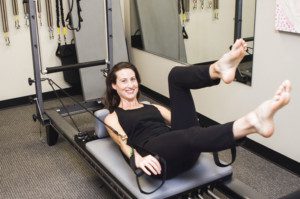 Pilates is a great way to exercise, assist with rehabilitation, and build body awareness and can be modified to appropriately meet everyone's needs. The different machines, or apparatuses, provide many exercises in a variety of different ways that will ensure your needs or goals are met. Working one on one with our instructor allows even more personalization to your workout by providing verbal and tactile feedback to make sure movements are being done correctly.
Pilates is a great way to exercise, assist with rehabilitation, and build body awareness and can be modified to appropriately meet everyone's needs. The different machines, or apparatuses, provide many exercises in a variety of different ways that will ensure your needs or goals are met. Working one on one with our instructor allows even more personalization to your workout by providing verbal and tactile feedback to make sure movements are being done correctly.
As with other forms of exercise, consistency is important. We recommend one to two sessions per week, depending on your needs.
See our Atlanta Pilates location:
Massage Therapy
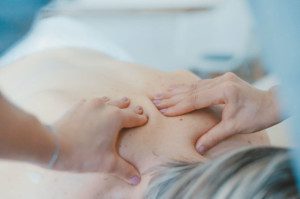 Massage therapy ranges from removing lymph in a drainage palpation to improving circulation to reduction of scar tissue. Massage Therapists also implement techniques that are focused on trigger points release and flexibility. More benefits from massage:
Massage therapy ranges from removing lymph in a drainage palpation to improving circulation to reduction of scar tissue. Massage Therapists also implement techniques that are focused on trigger points release and flexibility. More benefits from massage:
- Decrease pain and muscle tension.
- Improve circulation.
- Stimulate the lymphatic system.
- Improve joint mobility.
- Reduce stress.
See our Atlanta Massage location:
"I would recommend SetPT to anyone who is suffering and looking for a long-term fix. You must be willing to put in the time required and to accept that the program they teach you may be for the rest of your life. I only wish that I had known 20 years ago how specific exercises modified for my scoliosis would not only make for a prettier back but also prevent a decade of headaches." –M.C
